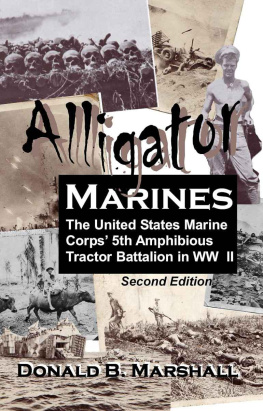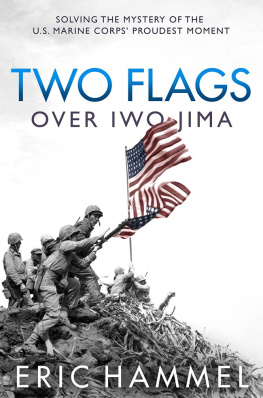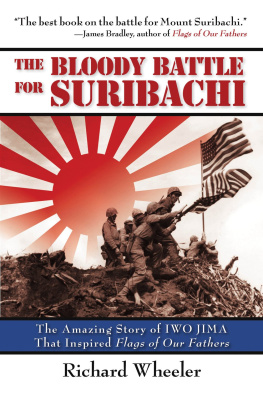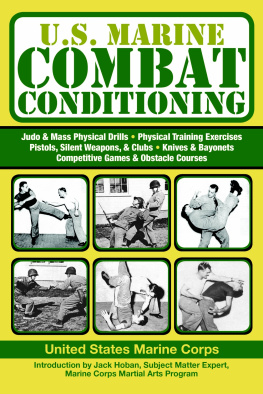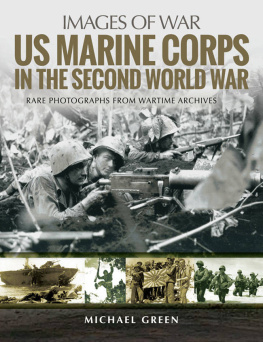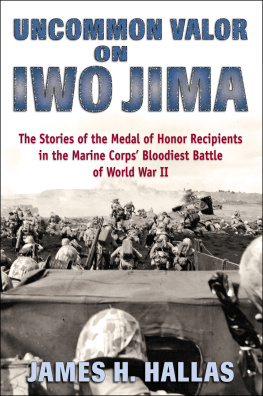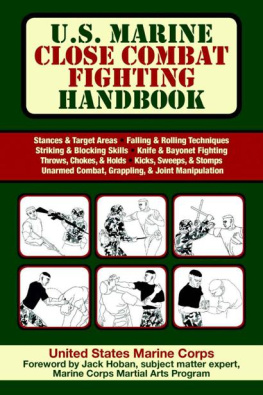Contents

MARINES
A story of the 5th Amphibious
Tractor Battalion in WW II
Saipan Tinian Iwo Jima
by Donald B. Marshall (who passed away in Nov. 2010)
Copyright 2007 by Donald B. Marshall and Day By Day Publishing
Published in the United States. All rights reserved. No part of this book may be reproduced in any form or by any means, electronic or mechanical, including photocopying, recoding, or by any information storage and retrieval system, without the written permission of the publisher.
Publisher: Day By Day
ISBN 978-1-934569-21-4 Digital
IS BN 978-1-934569-20-7 Paperback
Librar y of Congress Control Number: 2013951299
www.AlligatorMarines.com

Donald on Iwo Jima circa '44
Illustrations
A note about the illustrations. All of these drawings were done by the author generally using Japanese paper with their pens or pencils that he took off dead bodies or on the backs of letters from home. Many were drawn at night by candlelight on board the wrecked ship described in Chapter 29. Others were drawn on ship while returning to Maui after the battle of Iwo Jima. Drawn by a 17 year old amid the ravages of war, they communicate a stark reality of the revulsion of war and the price of freedom. You can see his drawing skills improve as time goes by. Don't look at the illustrations and judge him as a "poor artist." Donald was not trying to be an artist but record what he saw so that he could remember and share when the war ended.
During WWII, political correctness was not in style and as such, my Dad's drawings are unaffected by the current malaise called "political correctness." His story is also unaffected by it and I ask you not to judge him or this book by using the PC filter. I could have edited out the harsher sections and most outrageous words. I chose not to. This story should be read as one who wants to know what really happened, how people really thought and felt, not life as we would like to remember it. It is real. It is stark. It is World War II on the pacific front. ~Shelly Marshall, daughter of the author
INTRODUCTION
After a series of crushing American defeats throughout the vast pacific, the United States Marines fought battles at Guadalcanal, Tulagi, Tanagogo and Gavutu, in the first successful land actions against the Empire of Japan.
It was in these steamy islands where Marines adopted new techniques and tools to whip a tough and very clever enemy, tools and methods that would save many American lives in future actions. One of these new tools was the fat, clumsy LVT , landing vehicle, tracked, more commonly known as the Alligator.
In 1937, Life Magazine ran a story titled "Roebling's Alligator of Florida Rescue." The article centered on a raft-like vehicle being developed by engineer John Roebling and his son Donald for hurricane and/or swamp rescues.
Admiral Edward Kalbfus, recognizing the potential for amphibious operations, brought the article to the attention of General Louis Kittle and other USMC brass. A study was ordered. After a bit of a hassle, the Navy Bureau of Ships floated enough funds to develop this mobile raft. Roebling was not interested in the military aspect of the machine, but, after a bit of persuasion, he agreed to build another. He began working on a new model in 1940 at an estimated price tag of $20,000. It was completed for $16,000. Roebling wanted to return the balance, but his offer caused no end of confusion, as this had never before been done. Eventually, the vehicle was taken to Culebra Island for tests. Though underpowered and with unreliable tracks, it ran reasonably well, enough so that 100 Alligators were ordered.
In the spring of 1941, 26 Second Lieutenants were sent to Dunedin, Florida, under command of Major W. W. Davies, for training on these strange new crawlers. Second Lt. George Shead was one so assigned. When the war started, these officers and a few enlisted men were the only trained tractor men in the service. Realizing the potential of alligator men and their machines, Davies vigorously promoted expansion. Major Davies moved to Fleet Marine Force, Pacific (FMFPAC) as amphibious advisor. First and 2nd Amphibious Tractor battalions were formed as divisional units and so numbered. Alligator Marines, untried but eager, charged in combat with these huge, clumsy machines that were still in the early stages of development. Refinement would come only when the crews gained experience, and that came when the bullets were flying.
The first models, LVT-ls, clanked ashore in the South Pacific under many a jaundiced eye, not as assault weapons, but as cargo carriers.
Once in action, these ponderous, ugly monsters totally confused everyone, including the enemy.
Assuming certain terrain impassable to Marines, the Japanese occupying Guadalcanal concentrated their efforts on more defensible positions. They were appalled when the slow, clanking machines, which also served as a mobile machine gun platform and a rough but reliable ambulance, began rumbling through impassable territory with men and materials and, when idle, took up armored guard duty on the perimeter of camps, beaches and the all-important Henderson airfield.
Food Machinery Corp. of Riverside, California, an unlikely facility for building these cumbersome vehicles, was awarded the first contract. Their engineers eagerly awaited modifications recommended by the men in the best position to know... the Alligator Marines in the South Pacific.
Soon, improved LVTs were taking part in other actions. Halfway around the world, they delivered Army troops and supplies ashore against Vichy French positions in North Africa. Army command moved the LVTs north and engaged them in the Aleutians in the summer of 1943, then again at Rendova and Bougainville. Each time, the LVT proved itself a reliable and useful cargo vehicle but had yet to be tested under direct fire during an amphibious assault. This was soon to change.
Atolls are small, low island chains surrounded by protective coral reefs. As foreseen by those early Marine Corps planners, the LVT would be the ideal vehicle to overcome such barriers. Most of the thousands of atolls in the Pacific were fortified and occupied by the Japanese. Their presence caused serious logistical problems to the American war effort.
Makin and Tarawa atolls were the first in line for elimination. Heavily fortified Tarawa with its valuable airfield posed a constant threat to Allied communications. It was to be taken by the 2nd Div. Marines. Makin, 100 miles to the north, would be the Army's responsibility.
Major General Julian C. Smith, Commander of the 2nd Div., pointed out that Tarawa's reef would require more amphtracs than the 100 currently in his 2nd Amph Battalion. Furthermore, the machines available were in sorry shape after Guadalcanal.
Admiral Kelly Turner disagreed, insisting the Navy's usual landing craft, the LCVP Landing Craft Vehicle, Personnel, aka Higgins boat, would be satisfactory. Smith exploded and stated flatly that, if LVTs were not used, there would be no invasion!
Eventually, 75 of the LVT-ls were reconditioned, and an additional 50 of the new LVT-2s were located and formed into a new company. Battalion Commander Major Henry Drewes foresightedly ordered makeshift boiler plate armor attached to the fronts of the vehicles to bolster their original quarter-inch skin. The LVT-ls were armed with a .50-caliber machine gun forward and a .30 aft. The LVT-2s were fitted with .50- and .30-caliber machine guns forward and a single .30 aft. Grappling hooks were also fitted onto the tractors to pull up any barbed wire barriers.

